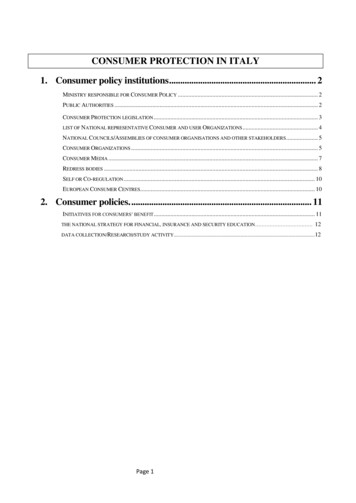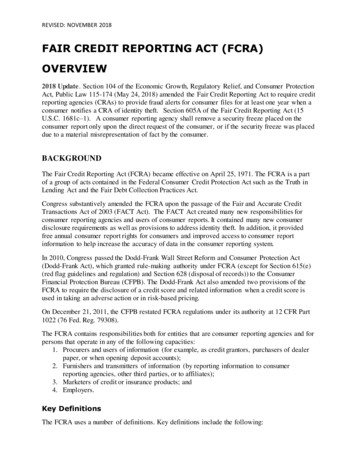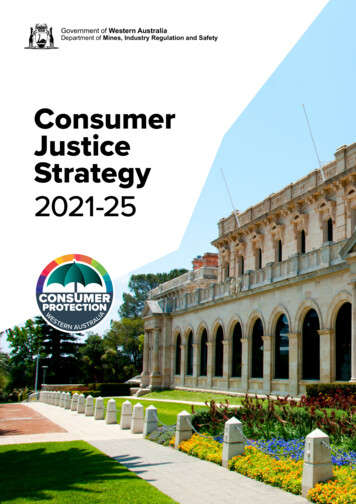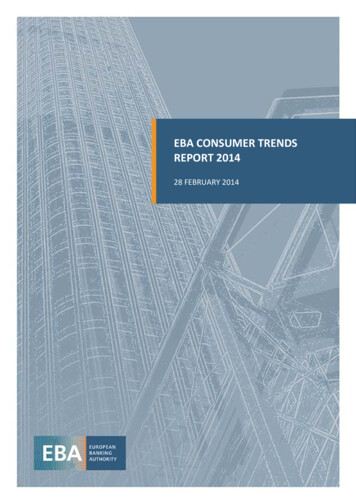
Transcription
Report of the Consumer FinancialProtection Bureau Pursuant toSection 1017(e)(4) of the DoddFrank ActDecember 30, 2016
Table of contentsTable of contents. 21. Executive summary . 51.1Listening to consumers . 61.2 Delivering for American consumers and leveling the playing field . 81.3 Building a great institution. 122. Budget . 132.1 How the CFPB is funded. 133. Diversity and excellence . 253.1 Recruiting and hiring . 253.2 Staff education, training, and engagement . 273.3 Diversity and inclusion . 294. Consumer challenges in obtaining financial products andservices . 384.1 Consumer concerns . 385. Delivering for American consumers and leveling the playing field . 625.1 Resources for consumers . 626. Regulations and guidance . 736.1 Implementing statutory protections . 732REPORT OF THE CFPB PURSUANT TO § 1017(E)(4) OF THE DODD-FRANK ACT
6.2 Addressing longstanding consumer protection and regulatory burdenconcerns in other markets . 766.3 Facilitating implementation of new regulations . 787. Supervision . 837.1Supervisory activities . 837.2 Supervisory guidance . 857.3 Coordination and information sharing with state regulators . 877.4 Examiner training and commissioning . 887.5 Technology . 898. Enforcement . 908.1 Conducting investigations . 908.2 Enforcement actions . 909. Fair lending . 1119.1 Fair lending supervision and enforcement . 1129.2 Interagency fair lending coordination and outreach . 1249.3 Home Mortgage Disclosure Act. 12610. Open government . 129Appendix A: . 132More about the CFPB . 132Appendix B: . 134Significant rules, orders, and initiatives . 134Appendix C: . 144Actions taken regarding rules, orders, and supervisory actions with respect tocovered persons which are not credit unions or depository institutions.1443REPORT OF THE CFPB PURSUANT TO § 1017(E)(4) OF THE DODD-FRANK ACT
Appendix D: . 148Significant state attorney general and regulator actions . 148Appendix E: . 149Reports . 149Appendix F: . 152Congressional testimony . 152Appendix G: . 153Speeches . . 153Appendix H: . 156Financial and budget reports . 156Appendix I: . 160CFPB organizational chart . 160Appendix J: . 161Defined terms . 1614REPORT OF THE CFPB PURSUANT TO § 1017(E)(4) OF THE DODD-FRANK ACT
1. Executive summaryThe Consumer Financial Protection Bureau (CFPB or Bureau) is pleased to present this report tothe Committees on Appropriations of the United States Senate and House of Representativesunder Section 1017(e)(4), in fulfillment of its statutory responsibility and commitment toaccountability and transparency. This report covers October 1, 2015 – September 30, 2016, theBureau’s 2016 fiscal year. 1The Dodd-Frank Act created the Bureau as the nation’s first federal agency with a mission offocusing solely on consumer financial protection and making consumer financial markets workfor American consumers, responsible businesses, and the economy as a whole. In the wake ofthe financial crisis of 2008, the President and Congress recognized the need to addresswidespread failures in consumer protection and the rapid growth in irresponsible lendingpractices that preceded the crisis. To remedy these failures, the Dodd-Frank Act consolidatedmost Federal consumer financial protection authority in the Bureau. 2 The Dodd-Frank Actcharged the Bureau with, among other things: Ensuring that consumers have timely and understandable information to makeresponsible decisions about financial transactions;1The previous appropriations report covered the time period October 1, 2014 – September 30, 2015.2Previously, seven different federal agencies were responsible for rulemaking, supervision, and enforcement relatingto consumer financial protection. The agencies which previously administered statutes transferred to the Bureau arethe Federal Reserve Board (and the Federal Reserve Banks) (Board or FRB), Department of Housing and UrbanDevelopment (HUD), Federal Deposit Insurance Corporation (FDIC), Federal Trade Commission (FTC), NationalCredit Union Administration (NCUA), Office of the Comptroller of the Currency (OCC), and Office of ThriftSupervision.5REPORT OF THE CFPB PURSUANT TO § 1017(E)(4) OF THE DODD-FRANK ACT
Protecting consumers from unfair, deceptive, or abusive acts and practices, and fromdiscrimination; Monitoring compliance with Federal consumer financial law and taking appropriateenforcement action to address violations; Identifying and addressing outdated, unnecessary, or unduly burdensome regulations; Enforcing Federal consumer financial law consistently in order to promote faircompetition; Ensuring that markets for consumer financial products and services operatetransparently and efficiently to facilitate access and innovation; and Conducting financial education programs. 3The Bureau has continued its efforts to listen and respond to consumers and industry, to be aresource for the American consumer, and to develop into a great institution worthy of theresponsibility conferred on it by Congress.1.1Listening to consumersListening and responding to consumers is central to the Bureau’s mission. The Bureau continuesto provide consumers with numerous ways to make their voices heard. Consumers nationwidehave engaged with the Bureau through public field hearings, listening events, roundtables, andtown halls, and through our website, consumerfinance.gov. Consumer engagement strengthensthe Bureau’s understanding of current issues in the ever-changing consumer financialmarketplace and informs every aspect of the Bureau’s work, including research, rule writing,supervision, and enforcement.36See Dodd-Frank Act, Pub. L. No. 111-203, Sec. 1021 (b) and (c).REPORT OF THE CFPB PURSUANT TO § 1017(E)(4) OF THE DODD-FRANK ACT
The Bureau has continued to improve and expand the capabilities of its Office of ConsumerResponse (Consumer Response) to receive, process, and facilitate responses to consumercomplaints. Consumer Response has also continued to develop and update a robust publicConsumer Complaint Database. As of September 30, 2016 the database was populated by over641,000 complaints from consumers about financial products and services from all over thecountry.In 2015, the CFPB marked a milestone for consumer empowerment when the Bureau began topublish consumer complaint narratives in the Consumer Complaint Database. 4 Consumers nowhave the choice to share in their own words their experiences with the consumer financialmarketplace. Only those narratives for which opt-in consumer consent is obtained and to whicha robust personal information scrubbing process is applied are eligible for disclosure. The CFPBgives companies the opportunity to respond publicly to the substance of the consumercomplaints they receive from the CFPB by selecting from a set list of public-facing responsecategories. Companies are under no obligation to avail themselves of the opportunity. As ofSeptember 30, 2016, the consumer complaint database included approximately 103,100narratives.Also in 2015, the Bureau launched a series of monthly reports to highlight key trends fromconsumer complaints submitted to the Bureau. The monthly report includes complaint data oncomplaint volume, most-complained-about companies, state and local information, and producttrends. Each month, the report highlights a particular product and geographic location and willprovide insight for the public into the hundreds of thousands of consumer complaints onfinancial products and services expected to be handled by the CFPB. The report uses a threemonth rolling average, comparing the current average to the same period in the prior year whereappropriate, to account for monthly and seasonal fluctuations. In some cases, month-to-monthcomparisons are used to highlight more immediate trends.47See Final Policy Statement on Consumer Narratives; 80 FR 15572, March 24, 2015.REPORT OF THE CFPB PURSUANT TO § 1017(E)(4) OF THE DODD-FRANK ACT
1.2Delivering for American consumers andleveling the playing fieldIn the past year, the Bureau has continued to expand its efforts to serve and protect consumersin the financial marketplace. The Bureau seeks to serve as a resource on the macro level, bywriting clear rules of the road and enforcing consumer financial laws in ways that improve theconsumer financial marketplace, and on the micro level, by helping individual consumersresolve their specific issues with financial products and services. While the various divisions ofthe Bureau play different roles in carrying out the Bureau’s mission, they all work together toprotect and educate consumers, help level the playing field for participants, and fulfill theBureau’s statutory obligations and mission under the Dodd-Frank Act. In all of its work, theBureau strives to act in ways that are fair, reasonable, and transparent.We are working to provide tools and information to develop practical skills and support soundfinancial decision-making directly to consumers. These skills include being able to ask questionsand to plan ahead. One way we are doing this is with our online tool, Ask CFPB. This toolprovides answers to over 1,000 questions about financial products and services, including ontopics such as mortgages, credit cards, and how to dispute errors in a credit report. Thisresource is found at consumerfinance.gov/askcfpb/. We are also focusing on helping consumersbuild the skills to plan ahead. For example, our Paying for College set of tools helps students andtheir families compare what their college costs will be down the road as they decide where topursue a college education. Our Owning a Home set of tools helps consumers shop for amortgage loan by helping them understand what mortgages are available to them, exploreinterest rates, compare loan offers, and by providing a closing checklist. The Money Smart forOlder Adults curriculum, developed with the FDIC, includes resources to help people preventelder financial exploitation and prepare financially for unexpected life events.We are working with other government agencies, social service providers, and communityservice providers to develop channels to provide decision-making support in moments whenconsumers are most receptive to receiving information and developing financial decisionmaking skills. This support includes integrating financial capability into other programs andservices where consumers may be seeking assistance. We are also tailoring our approaches tofinancial decision-making circumstances, challenges, and opportunities for specific populations,including servicemembers and veterans, students and young adults, older Americans, andlower-income and other economically vulnerable Americans.8REPORT OF THE CFPB PURSUANT TO § 1017(E)(4) OF THE DODD-FRANK ACT
When Federal consumer financial protection law is violated, the Bureau’s Supervision,Enforcement, and Fair Lending Division is committed to holding the responsible partiesaccountable. During FY 2016, the Bureau’s supervisory actions resulted in financial institutionsproviding more than 58 million in redress to over 516,000 consumers, and the Bureau has alsoannounced orders through enforcement efforts for approximately 247 million in total relief forconsumers who fell victim to various violations of consumer financial protection laws, alongwith over 83.7 million in civil money penalties. The Bureau has also continued to develop andrefine its nationwide supervisory program for depository and nondepository financialinstitutions, through which those institutions are examined for compliance with Federalconsumer financial protection law.Continuing the CFPB’s policy of transparency, the Bureau has released four editions ofSupervisory Highlights during this fiscal year, including one special edition. These editionsdiscussed examination findings and regulatory violations or unfair, deceptive, or abusive acts orpractices in the areas of consumer reporting, debt collection, student loan servicing, mortgageorigination, mortgage servicing, and fair lending. The special edition reminded institutions ofModule 4 of the Equal Credit Opportunity Act (ECOA) baseline review modules used by Bureauexaminers to evaluate compliance management systems under ECOA. Among other things,Module 4 contains questions regarding fair lending training of servicing staff, fair lendingmonitoring of servicing, and servicing of consumers with Limited English Proficiency.Supervisory Highlights is intended to inform both industry and the public about thedevelopment of the Bureau’s supervisory program and to discuss, in a manner consistent withthe confidential nature of the supervisory process, broad trends in examination findings in keymarket or product areas.The Bureau has also published new examination procedures and supervisory guidancedocuments, in partnership with other regulators where appropriate, to help institutions knowwhat to expect and how to become, or remain, compliant with the law, including bulletinson Real Estate Settlement Procedures Act (RESPA) compliance and marketing servicesagreements, the revised supervisory matters appeal process, requirements for consumerauthorizations for preauthorized electronic fund transfers, on in-person collection of consumerdebt, on the furnisher Fair Credit Reporting Act (FCRA) obligation to have reasonable writtenpolicies and procedures, submission of credit card agreement under TILA, interagency guidanceregarding deposit reconciliation practices, guidance on the new Uniform Residential LoanApplication, Regulation B compliance, and collection of expanded Home Mortgage DisclosureAct (HMDA) information about ethnicity and race in 2017.9REPORT OF THE CFPB PURSUANT TO § 1017(E)(4) OF THE DODD-FRANK ACT
Reasonable regulations are essential for protecting consumers from harmful practices andensuring that consumer financial markets function in a fair, transparent, and competitivemanner. The Research, Markets, and Regulations Division has focused its efforts on promotingmarkets in which consumers can shop effectively for financial products and services and are notsubject to unfair, deceptive, or abusive acts or practices. During this reporting period, theResearch and Markets teams released reports on the consumer credit card market, which isdescribed in detail in Section 2.3, mobile financial services, college credit card agreements,reports on third party debt collection operations and, jointly with the Federal Housing FinanceAgency (FHFA), a technical report about a profile of 2013 mortgage borrowers that includesstatistics from the National Survey of Mortgage Originations.The Office of Regulations issued regulations modifying and clarifying a number of rulesimplementing changes made by the Dodd-Frank Act to the laws governing various aspects of themortgage market. During this fiscal year, the Bureau has published several proposed or finalrules or requests for information under the Dodd-Frank Act, including a final rule to implementamendments to HMDA, adding new reporting requirements and clarifying several existingrequirements; a final rule making technical corrections to Regulation Z with respect to the KnowBefore You Owe (KBYO) rule; a final rule adopting a procedural rule establishing an applicationprocess under which a person may identify an area that has not been designated by the Bureauas a rural area for the purposes of a Federal consumer financial law and apply for such area to beso designated; an interim final rule that expanded eligibility for special provisions and added anexemption from requirements provided to certain small creditors operating in rural orunderserved areas under the Bureau's mortgage rules; a notice and request for informationregarding HMDA resubmission guidelines, which describe when supervised institutions shouldcorrect and resubmit HMDA data; and a final rule amending certain mortgage servicing rulesissued in 2013 under the Real Estate Settlement Procedures Act (RESPA) and the Truth inLending Act (TILA). These amendments focus primarily on clarifying, revising, or amendingprovisions regarding force-placed insurance notices, policies and procedures, early intervention,and loss mitigation requirements under Regulation X’s servicing provisions; and periodicstatement requirements under Regulation Z’s servicing provisions. In conjunction with this finalrule, the Bureau issued an interpretive rule under the Fair Debt Collection Practices Act(FDCPA), which constitutes an advisory opinion for purposes of the FDCPA and provides safeharbors from liability for servicers acting in compliance with specified mortgage servicing rulesin Regulations X and Z in three specific situations. Additionally, following the issuance of aMarch 2015 report, in May 2016, the Bureau proposed a rule concerning the use of agreementsproviding for arbitration of any future dispute between covered persons and consumers in10REPORT OF THE CFPB PURSUANT TO § 1017(E)(4) OF THE DODD-FRANK ACT
connection with the offering or providing of consumer financial products or services. Theproposal would prohibit covered providers of certain consumer financial products and servicesfrom using an arbitration agreement to bar the consumer from filing or participating in a classaction. Under the proposal, companies would still be able to include arbitration clauses in theircontracts, but for contracts subject to the proposal, the clauses would have to say explicitly thatthey cannot be used to stop consumers from being part of a class action in court. The Bureau hasreceived several thousand comments on the proposal and is considering development of a finalrule for Spring 2017. Finally, in July 2016, the Bureau published a notice of proposedrulemaking and request for comment on payday loans, auto title loans, and other similar creditproducts. Among other things, the proposal would require lenders to make a reasonabledetermination that the consumer has the ability to repay a covered loan before extending credit.It would also require lenders to make certain disclosures before attempting to collect paymentsfrom consumers’ accounts and restrict lenders from making additional payment collectionattempts after two consecutive attempts have failed.To support the implementation of and industry compliance with its rules, the Bureau haspublished plain-language compliance guides and video presentations summarizing them, andactively engaged in discussions with industry about ways to achieve compliance. 5 The Bureaualso continued its efforts to streamline, modernize, and harmonize financial regulationsinherited from other agencies.In addition to implementing the Dodd-Frank Act, the Bureau is exploring other areas whereregulations may be needed to ensure that markets function properly and possibly harmful orinefficient practices are addressed. Over the next fiscal year, the Bureau will continueimplementing the Dodd-Frank Act and using its regulatory authority to ensure that consumershave access to consumer financial markets that are fair, transparent, and ce/#compliance.11REPORT OF THE CFPB PURSUANT TO § 1017(E)(4) OF THE DODD-FRANK ACT
1.3Building a great institutionAs we celebrated our fifth anniversary fighting for consumers, the Bureau continues to grow andevolve as an institution. As of September 30, 2016, the CFPB team consisted of 1,587 employeesworking to carry out the Bureau’s mission. It has worked to build a human and physicalinfrastructure that promotes – and will continue to promote – diversity, transparency,accountability, fairness, and service to the public, including: Demonstrating a strong commitment to openness and utilizing the Bureau’s website toshare information on its operations; Recruiting highly-qualified, diverse personnel; Providing training and engagement opportunities for CFPB staff to improve skills,increase knowledge, and maintain excellence; and Further promoting diversity and inclusion in the CFPB’s workforce and among itscontractors, including through the Bureau’s Office of Minority and Women Inclusion(OMWI).The Bureau recognizes that the best way to serve consumers is to ensure that its workforcereflects the ideas, backgrounds, and experiences of the American public. OMWI supports theBureau’s mission by working with the offices of Human Capital and Equal EmploymentOpportunity to continue building a diverse and inclusive workforce, with which the Bureau canfoster broader and better thinking about how to approach markets.We will continue working hard to ensure that the American people are treated fairly in theconsumer financial marketplace. We encourage you to visit consumerfinance.gov for updates.12REPORT OF THE CFPB PURSUANT TO § 1017(E)(4) OF THE DODD-FRANK ACT
2. BudgetThe Bureau is committed to fulfilling its statutory responsibilities and delivering value toAmerican consumers by being accountable and using resources carefully. The CFPB’sOperations Division is responsible for coordinating activities related to the development of theCFPB’s annual budget. The Office of the Chief Financial Officer within the Division has primaryresponsibility for developing the budget, and works in close partnership with the Office ofHuman Capital, the Office of Procurement, the Technology and Innovation team, and otherprogram offices to develop budget and staffing estimates in consideration of statutoryrequirements, performance goals, and priorities of the Bureau. The CFPB Director ultimatelyapproves the CFPB budget.2.1How the CFPB is fundedThe CFPB is funded principally by transfers made by the Board of Governors from the combinedearnings of the Federal Reserve System, up to the limits set forth in the Dodd-Frank Act. TheDirector of the CFPB requests transfers from the Federal Reserve System in amountsdetermined to be reasonably necessary to carry out the Bureau’s mission. Annual funding fromthe Federal Reserve System was capped at a fixed percentage of the total 2009 operatingexpenses of the Federal Reserve System, equal to: 10% of these Federal Reserve System expenses (or approximately 498 million) in fiscalyear (FY) 2011; 1311% of these expenses (or approximately 547.8 million) in FY 2012; andREPORT OF THE CFPB PURSUANT TO § 1017(E)(4) OF THE DODD-FRANK ACT
12% of these expenses (or approximately 597.6 million) in FY 2013 and each yearthereafter, subject to annual adjustments. 6The adjusted transfer cap for FY 2016 was 631.7 million. The adjusted transfer cap for FY 2017is 646.2 million. The CFPB requested transfers from the Federal Reserve totaling 564.9million to fund CFPB operations and activities through the fourth quarter of FY 2016. 7 Thesefunds are held in an account for the Bureau at the Federal Reserve Bank of New York.Bureau funds that are not funding current needs of the CFPB are invested in Treasury securities.Earnings from those investments are also deposited into the Bureau’s account. 8Bureau funds that are not funding current needs of the CFPB, however, are invested in Treasurysecurities. Earnings from those investments are also deposited into the Bureau’s account. 9If the authorized transfers from the Federal Reserve were not sufficient in FY 2010-2014, theCFPB had the authority in those fiscal years to ask Congress for up to 200 million in additionalfunds, subject to the appropriations process. 10 The CFPB did not request an appropriation in FY2011, FY 2012, FY 2013, or FY 2014. That authority has now expired.6See Dodd-Frank Act, Pub. L. No. 111-203, Sec. 1017(a)(2).7 TheBureau posts all funding request letters on its website at consumerfinance.gov/budget.8 SeeDodd-Frank Act, Pub. L. No. 111-203, Sec. 1017(b).9 SeeDodd-Frank Act, Pub. L. No. 111-203, Sec. 1017(b).10 See14id. Sec. 1017(e).REPORT OF THE CFPB PURSUANT TO § 1017(E)(4) OF THE DODD-FRANK ACT
2.1.1Fiscal year 2016 spendingIn the fiscal year that ended on September 30, 2016, the CFPB incurred approximately 575.6million in obligations 11 to carry out the authorities of the Bureau under Federal consumerfinancial law. Approximately 290.3 million was spent on employee compensation and benefitsfor the 1,591 CFPB employees who were on-board by the end of the fiscal year.In addition to payroll expenses, the largest obligations made through the end of the fiscal yearwere related to contractual services. Some of the Bureau’s significant obligations that occurredin FY 2016 included: 16.1 million for maintaining ongoing operations of CFPB's consumer contact center andcase management system, both of which are critical front-line systems that enabled theBureau to handle more than 283,000 complaints in fiscal year 2016; 14.4 million for IT portfolio and project management support services, which assist andsupport the Bureau in its on-going efforts to develop, sustain and mature its IT programmanagement and business process capabilities; 14.1 million to the Board of Governors of the Federal Reserve System for servicesprovided by the Office of the Inspector General of the Board of Governors of the FederalReserve System and the Consumer Financial Protection Bureau; 13.9 million to empower and educate American consumers through paidcommunications to help people discover and use the bureau’s tools and resources; 12.9 million for a one-year building occupancy agreement with the General ServicesAdministration for CFPB’s temporary headquarters office space; 12.5 million for a one-year building occupancy agreement with the Office of theComptroller of the Currency;11 Anobligation is a transaction or agreement that creates a legal liability and obligates the government to pay forgoods and services ordered or received.15REPORT OF THE CFPB PURSUANT TO § 1017(E)(4) OF THE DODD-FRANK ACT
9.1 million for continued development of a cost-effective, internally managed cloudinfrastructure; 8.4 million for operation and development of the cybersecurity program that
4 See Final Policy Statement on Consumer Narratives; 80 FR 15572, March 24, 2015. 8 REPORT OF THE CFPB PURSUANT TO § 1017(E)(4) OF THE DODD-FRANK ACT . 1.2 . Delivering for American consumers and











